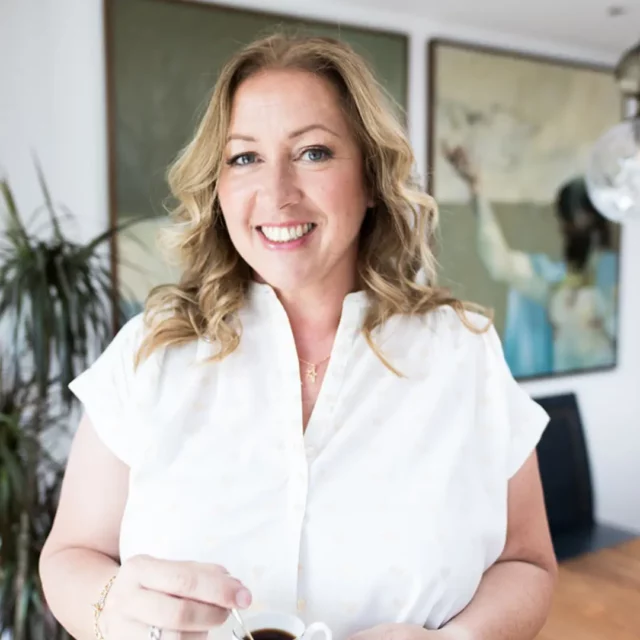Catherine Erdly: Welcome to episode number 175 of the resilient retail game plan. Hi everybody. I’m Catherine Erdly. I’m your host as well as the founder of the resilient retail club. That is my membership group and mastermind for product businesses. Head over to resilientretailclub.com to find out more. And if you use the code 10 podcast you’ll get 10 pounds off your first month in the Resilient Retail Club.
Today, we have a fabulous guest talking about a really important topic. I’m so excited for you to hear today’s conversation because I think it’s really going to open your eyes and make you think a little bit differently about what you can negotiate on in your business. Our guest today has got a really long history of working in retail, and he absolutely knows this subject inside out.
Can’t wait to share it with you.
Welcome to the Resilient Retail Game Plan, a podcast for anyone wanting to start, grow or scale a profitable creative product business with me, Catherine Erdly. The Resilient Retail Game Plan is a podcast dedicated to one thing, breaking down the concepts and tools that I’ve gathered from 20 years in the retail industry and showing you how you can use them in your business. This is the real nuts and bolts of running a successful product business, broken down in an easy, accessible way. This is not a podcast about learning how to make your business look good. It’s the tools and techniques that will make you and your business feel good.
Confidently plan, launch and manage your products and feel in control of your sales numbers and cash flow to help you build a resilient retail business.
Simon, thank you so much for joining me today.
[01:51] Welcome Simon Duncan
Catherine Erdly: Do you want to start us off by introducing yourself and what you do?
Simon Duncan: Well, first of all, thank you very much, Catherine, for inviting me on. It’s an absolute pleasure. I’m Simon Duncan and in terms of my background, I’ve been in retail for about 35 plus years. I set up my own consultancy about five years ago, but pre that I was director of House of Fraser, where I had the commercial responsibility for negotiating and dealing with all the brands that traded in House of Fraser, of which there was, I don’t know, about 500 brands and about 900 million turnover or something like that.
But I set up my own consultancy, as I say, about five years ago, and really what it is all about for me is I work with numerous brands and retailers now on the creation and leading of structured and rigorous and collaborative negotiation strategies, which basically ensure sustainable commercial models for the future and really allows businesses to maximize opportunities.
So that’s who I am.
Catherine Erdly: That’s who you are. I know we delved into this a little bit before when we had our first chat about the podcast. I’m sure our paths will have crossed in those years in retail. It’s such a small world when you get into it.
Simon Duncan: Extremely.
Catherine Erdly: But I’m really excited about our chat today because I think it’s going to be so incredibly useful for lots of people listening. And I think it’s amazing to have someone with your background, deep knowledge of negotiation in a retail specific context, which has its own sort of particular way of negotiating.
[03:44] Why is negotiation such an important skill for retail business owners to have?
Catherine Erdly: So let’s talk about negotiation in general. Why do you think it’s such an important skill for business owners to have?
Simon Duncan: Well, the first thing I would say is that negotiation is basically the oldest form of trading whether or not it’s for a product or a service. And it’s effectively taking place millions of times a day around the world between people trying to buy and sell. And I fully appreciate that your listeners, being business owners will be involved and have, many skills about running their business, from pure buying products, but also financial planning and marketing and procuring, whether or not that’s with the brands they’re buying in or wholesale or indeed their landlords, et cetera.
So all of those dealings that they are having are effectively some sort of transaction. And that is why you absolutely need to ensure that you have good negotiation skills in order to be able to survive and secure value for money, whether or not that’s on commercial deals or operational deals. So negotiation, as far as I’m aware, within retail particularly, is absolutely a core skill that you need to have in order to be able to move forward and survive.
Catherine Erdly: That’s so true. So it runs through pretty much everything that people are doing.
Simon Duncan: Absolutely. As I say, when in retail, when you think about negotiation people immediately start thinking about, well, it’s to do with the buyers and the merchandisers actually buying the products. But actually it’s more than that. It’s about with the buyers and the merchandise, yes you’re buying a product, but you’re also trying to formulate a collaborative partnership.
But also, within marketing areas or e-com or finance or even HR, you’re usually buying some type of service. And therefore, again, it goes back to this buying and selling, if you’re buying and selling, you’re negotiating.
Catherine Erdly: Yeah, for sure.
[05:50] What are some of the key areas that retail owners don’t negotiate (and should!)? And where would negotiating help help the bottom line the most?
Catherine Erdly: So when you come in and work with businesses, retail businesses and work with them on the negotiation and looking at areas in which they can negotiate, where are some of the key areas that maybe you find that people generally don’t negotiate where they could or equally where you just think, right, this is the key area that’s going to help the bottom line the most?
Simon Duncan: Over the last five years, particularly with my own consultancy, I’ve worked with about four or five different brands where I go in and do an end to end negotiation strategy. And effectively, to be honest with you, Catherine, it’s really across their supply chain.
Whenever I go into a business, I’ll sit down with the teams and I’ll assess what the current trading terms are within brands that they’re buying in, or maybe wholesale partners they’re selling out to, but also their manufacturers of their own label products, but it’s also their logistics companies, their distribution, the warehousing companies that they use.
It may well also cover categories such as agencies that they use within marketing and point of sale material. And indeed, in procurement companies, retailers are usually buying products not for resale. In other words, like the carrier bags that they’re giving that product to the customer in.
And then, slightly more tricky, negotiations with landlords and indeed utility suppliers, whether or not that’s electricity, gas, your phone, whatever. So in fact, there are numerous categories within the supply chain, obviously, that you need to be looking at to ensure that you’re getting best value.
Admittedly, the key ones are going to be around the product. So the brands and the wholesale partners and your private label, if you’re actually manufacturing product.
Catherine Erdly: So do you think it’s almost like everything’s negotiable?
Simon Duncan: Well, yeah, it’s that old adage, if you don’t ask, you don’t get, so, there are tougher areas and, I’ll probably come on to those and what are the key things you really need to think about when you go into negotiation, but it’s a lot to do with balance of power.
And it’s a lot to do with what’s the longevity of the relationship that you want. So, when you are buying product, yes, you are actually trying to establish a collaborative long term relationship, but then that brings about the area for potential for negotiation. When you get into utilities, yeah, fine that’s a bit of a tougher one.
Catherine Erdly: Right.
Simon Duncan: You’re doing logistics and you’re dealing with somebody like DHL.
Well, your balance of power is not massive there, but there is still scope to negotiate. You should be looking at all your profit lines. The thinking about where is there potential to get leverage in order to be able to negotiate a better deal.
Catherine Erdly: That brings us on perfectly to the next point then. So if somebody’s listening to this, they’re thinking, okay, right, yes, that sounds like something I really need to look at. I’m going to start thinking about everywhere we spend money as a business.
Simon Duncan: Yeah.
[09:19] What are some of the key steps that owners should take before entering into a negotiation situation?
Catherine Erdly: So if they’re feeling inspired to start looking at their own key areas for negotiation, what are some of the key steps that people should take before entering into a negotiation situation?
Simon Duncan: Well, there’s a lot to be considered and thought about before you even start a negotiation.
Catherine Erdly: I was going to say, I should really say that I know that this is something that you cover when you do negotiation training, you cover in a huge amount of depth. So appreciate I’m asking you to distill this.
Simon Duncan: I’ll try and keep it tight, but it’s just really important to understand that, first of all, the planning stage, in other words, before you even start a negotiation, the planning stage is absolutely critical. And to be honest with you, you should be spending 80, 85 percent of your time just purely on planning. As in 80, 85 percent of time right from the very beginning of your planning right through to actually securing the deal.
Because the more you plan, the more confident you’re going to be and the more in control you’ll have and negotiation is about confidence and it is about control. So the things you need to think about. before you even start a negotiation…
First of all, it sounds simple, but understand exactly what you are really trying to achieve. What are the current facts of the business relationship? When you’re looking at a particular partner, how do their trading terms relate to other trade partners, or indeed to that type of partner within the marketplace? As I’ve mentioned briefly, it’s the balance of power that you have, not just with the company you’re dealing with, but also the individual that you might be having that negotiation with, because you might have a big business with limited balance of power for yourself, but with the individual, you may be one of their key clients and therefore you have power with them.
Catherine Erdly: Got it.
Simon Duncan: Another big thing is mindset. So what’s important to you? Yes, absolutely. But you also really need to get into your counterpart’s mindset and understand what’s important to them. What do they need? What are they actually trying to get out of the negotiation? Because there may well be stuff that you can actually compromise on, show collaboration and give them that’s low cost value to you, but high value to them.
Also, if you’re dealing with lots of brands, perhaps that you’re buying in, it’s have a view of segmenting them into simple categories to really try and get the true focus. So there’s a common stas, the 80/20 rule. I reckon probably the majority of your listeners within their own businesses, if they really truly evaluated where they’re actually getting their profit from, 80 percent of their profit is likely to be coming from 20 percent of their partners.
So those are the guys that are really important to you. They’re what we call nurture partners. And those are the ones where you are going to have to negotiate and compromise and be collaborative on Most of your listeners will then, if they assess, will have have 60 percent or so that are what we call exercise.
And those are the guys who might be giving you quite big value and scale, but actually, you could probably flip the relationship to a completely separate partner, and it wouldn’t really affect your overall business. And those are the guys that initially you’ll defend your negotiation ask. You may well get into a bit of negotiation afterwards.
And then I can guarantee again, in every business, there is a long tail partners that may be actually about 20 percent of your overall mix, but will be a significant number of partners that are actually giving you diddly squat. And really, at the end of the day, they’re expendable.
So in other words, you put out what your new terms are going to be, and those are the guys that you’re actually going to defend throughout, to the point that if they don’t agree, you cease business with them.
Catherine Erdly: And when you say defense, so that means you stick to your guns.
Simon Duncan: Yeah, the next part of the planning is, when you go out for an ask, when you go out to say, right, these are the new terms that are going forward, you can’t just say that straight off, you need to give it some sort of basis and some sort of justification.
So you need to create a story about your business based on facts that shows the justification for the ask. And also, you need to try and put in something in there that says, right, whilst we may be moving to improved terms for ourselves, the opportunity for you in the longer term by dealing with us is growth for you as well.
Catherine Erdly: Right.
Simon Duncan: With your small harvest brands, those are the ones you just say, look, there’s opportunity for you, but you have to be on these terms. If you’re not on these terms, we can’t go ahead.
[14:41] What can be negotiated?
Catherine Erdly: So let’s get a concrete example. So if you’re an independent retailer and you’re looking at specifically negotiating with the people that are supplying goods to you, so the people you’re buying from so you’d go through and you’d say, right, 80 percent of my profit is coming from this 20 percent of brands.
And they’re the ones it’s a little bit more handholding with, right? Let’s say you’ve looked at your cashflow and you think, right, okay, I need to push my payment terms. I can’t pay upfront anymore, or I’ve got to extend it. Most small retailers will have much shorter payment terms than big retailers, for example, but let’s say you just say, okay, actually, or next year for Christmas I really need to spread out the payments for my Christmas stock because it’s just too much of a pinch point. Then you’re going to say, right, these people are my nurture. These are my 80 percent of my business, my profits coming from these. So it’s going to be much more collaborative, what can we do here?
And ultimately you know that you don’t want to cease trading with them because they’re really important to you. And then you’ve got the rest. . Some will be more important to you than others, but you know that there’s a whole bunch of people that you’re not really getting much profit from.
So you’re just going to say, look, I’m going to be spreading out payments of my Christmas stock next year. And if they say, oh, that doesn’t work for us, you’re like, okay, tough.
Simon Duncan: It’s how hard you go into that negotiation. When you’re nervous you’re going to be more compromising. You want to push out your settlement terms or your payment days. Let’s say you want to push them out of 30 days. You might actually start your negotiation by saying, we’re going to go out to 60 days payments. However, we are prepared to pay you 30 days, but in return for paying 30 days, we want a 2 percent settlement discount.
Catherine Erdly: Yeah.
Simon Duncan: And then when you come into the negotiation, what you may well end up on is getting the payment terms out in 30 days with no settlement discount. But that’s actually what you were targeting in the first place.
Catherine Erdly: Right. Yeah.
Simon Duncan: So the next part of the planning process, once you get your justification, is actually thinking about where’s your start position, which is called the anchor. So if you’re going for 30 day payment terms from currently 15, you may want to start at 45, 60 days, and then your break point, if you’re targeting 30 days is 30 days.
So you go out asking for 60, your break point is 30. And then it’s thinking about the moves you can make in between your endpoints. Because if you ask for 60 days, the likely response you’re going to get is, no chance.
Catherine Erdly: Yeah.
Simon Duncan: Okay, well, perhaps we can move to 45 days, but for 45 days, I’m going to have to get a 1 percent settlement discount from you.
Catherine Erdly: Right.
Simon Duncan: No, that’s still too long. All right, well, perhaps we can compromise on 30 days, but in return for 2 percent settlement discount. Those moves in between your anchor and your break point are called variables. And we’re just talking purely right at this moment, Catherine, about, payment days and settlement discount.
But there’s other things you can bring in there, like marketing contribution. Or potentially giving them better locations within your store or on your website. It’s amazing how often people just want regular communication. So you could commit to saying, right, we’ll have a quarterly meeting, maybe on Zoom or whatever.
Lots of people will actually take that on board and think that is a really credible positive. And therefore, yeah, maybe I am prepared to accept the extension of payment terms.
Catherine Erdly: Yeah.
Simon Duncan: And you should be able to come up with quite a few of those.
Catherine Erdly: Yeah. So sometimes it will be payment terms. Another common example that I run into with my clients would be, for example, somebody who’s manufacturing products and then it’s all about dealing with the manufacturers and suppliers. I often say to people, have you ever asked for a price improvement if you’ve been with somebody for a couple of years now and you’ve proven to them that you’re a really good customer and you’re buying from them regularly I think you know, there’s absolutely nothing wrong with going back and saying ,well look you know me now, I’m good for these orders.
Okay, let’s talk about pricing.
Simon Duncan: It it comes back to what I said before. It’s like, if you don’t ask, you don’t get, and I think a lot of independent and indeed some of the smaller brands that I’ve dealt with, which I won’t name, but brands who are doing like 30 odd million turnover have felt as though they’re in a weak position.
So they never ask. And the manufacturer says, right, we’ve got to increase the cost by 8 percent this season. And I’ve said, well, what do you do when they say that and they go, well, we have to accept it. I said why do you have to accept it? It may be that you do accept an increase of sorts. But you need to get something back in return i. e. better payment terms.
Just really quickly two examples of two brands that people everybody will know. I used to deal with Mulberry. Now the absolutely key thing for Mulberry whenever we opened a new store was they wanted the prime location.
So what did I never offer them in the first instance? I never offered them the prime location. Because I knew that’s what they wanted. So my compromise was then right, okay, fair enough. You’re Mulberry. You’re wonderful. We love you, et cetera, et cetera. We’ll give you the prime location, but I want a better margin on the product in return for it.
There’s another brand called Villeroy and Boch, it was a premium tabletop brand and it was run by a very old school gentleman, a charming guy, but he was all about relationship. So I then brought in this staggered tiering of relations, which said you’re either a premium, gold, silver, or a bronze supplier.
And I deliberately made them silver because I knew that would get his goat. He said, but we need to be premium. So we ended up saying, okay, we’ll put you on a trial premium stage for two seasons, but only on condition that you give us the marketing contribution and payment terms, et cetera. To which they go, great, I’m now a premium supplier.
Therefore, that’s what I want. And I’m happy to give the marketing or whatever. And this goes back to what I said about low cost gives for high value gain. It cost me nothing to make them a platinum. I just had to commit to a couple more regular meetings. So what you have to think about pre negotiation is all these things I’ve said.
It is absolutely essential to plan in advance. And it’s like, again, another really old saying, which is so true is fail to plan, you are planning to fail. Simple as that. I’m going back to my start point about planning. Everybody’s anxious when they go into a negotiation, even if you’re the best bloody negotiator out there.
That’s not a bad thing because it creates a bit of adrenaline. But if you’ve planned, then you will feel more confident or you will be able to display more confidence and control. And that’s what a hell of a lot of negotiation is about, so it’s the planning, but then also obviously it’s about all the psychological things that you need to take into account when you actually come face to face with a negotiation.
Catherine Erdly: Because if you’ve got all your points worked out, then you’ve got that confidence. It’s like a chess game, isn’t it?
Simon Duncan: And I’ve used that example, I don’t know if your listeners watched The Queen’s Gambit?
Catherine Erdly: Right.
Simon Duncan: It was amazing, if you look at it from a negotiation point. She was an excellent player, but she did so much detailed preparation on who her opponent was going to be, how they play, do they hesitate, which pieces do they move first of all.
And then she created her anchor position, which was a really strong opening move. But she was constantly thinking, what’s their next move? How do I react to that? Thinking sort of five, six moves in advance. And this is where you get your anchor to your break point. You’ve already planned your moves because they’re not going to accept the first thing you say.
And it’s how you then get to that end point, which is success. But yeah it is like a game of chess.
[23:47] How do you figure out what people want before you negoitate with them?
Catherine Erdly: How do you figure out what people want? That was the one thing that jumped into my mind. Because, obviously, sometimes, I guess with Mulberry, it was experience, right? You knew every time you had a new store, they would say, oh, but we want the prime spot. So you’re like, okay, that’s what they want.
So is part of it just you have to start trying? Let’s say you’ve got a manufacturer in Turkey that you do a lot of your knitwear or sweatshirts with, and you think, right, okay, I really want to try and push my price or not accept a pricing increase.
Let’s face it, that’s half of the negotiation at the moment. So how do you just make a guess at what you think they might want? Or can you ask?
Simon Duncan: This goes back to this point about trying to get into the mindset and trying to figure out what they want because I mean, I guess with the majority of your partners that you’re dealing with, you’ll have some experience of them in the past and you should be able to get a good feel for what is important for them.
And if it’s a new supplier, I’m sure that you’ll have contacts or you can do loads of research on them in terms of what type of businesses they deal with, how they deal with them, et cetera. With manufacturing in Turkey, for example, a lot of the Turkish manufacturers love regular communication.
So committing to talking to them on a business review on a quarterly basis might actually get them over the line. If they’re forcing a cost price increases on you, a lot of them will accept retrospective discounts. So in other words, based on volume. Or some of them actually just want commitment.
So you can say, right, I will commit for a 6 months, 12 months period from you, but that is only on condition that there aren’t any cost price increases within that period of time.
It’s again about saying, look guys, there’s an opportunity for you because I will buy more from you, but on condition that you’re not going to screw me on price.
Catherine Erdly: Right.
Simon Duncan: And when you come to thinking about mindsets and all the different things that you can bring into the negotiation between your anchor and your breakpoint, quite seriously, if you sat down or I sat down with a team of guys from a brand, I’d probably be able to come up with about 15 to 20 different variables that you could bring into the negotiation.
Some of them won’t be worthwhile with certain partners, some will be more worthwhile. But again, it’s about thinking about the mindset of your counterpart.
Catherine Erdly: What’s important to them.
Simon Duncan: Yeah, absolutely. Negotiation’s not all about yourself.
Catherine Erdly: Right.
It’s
Simon Duncan: very much about trying to figure out what’s important for the others.
Catherine Erdly: And I suppose the more you do it with a particular partner as well, then the more you understand.
Simon Duncan: I must admit, you can only push it so far. I mean, like the Mulberry thing, I did that. I actually successfully did that over three new stores over about 18 months and the MD realized what the hell I was doing. And I had to move to a different strategy but it worked for 18 months.
[27:01] These are the key skills needed to negotiate
Catherine Erdly: So it’s about asking right? And this is the thing I think you absolutely nailed it when you said earlier that a lot of people think that they’re in a weak position so they don’t even ask but if you don’t ask you don’t get so you might as well try.
Simon Duncan: Yeah. Because again, another thing with the negotiation, as I said at the beginning, is you’ve got to create a bit of a justification for why you’re asking it rather than just going, I’m demanding.
If you’ve got a justification you can ask fairly forcefully, but in a very polite, collaborative way .
And indeed, another part of negotiation is empathy.
This is about the psychological skills you need. It’s demonstrating that you’re actively listening to their point of view and you are trying to take into account what they need as well. That’s where the psychological side is needed.
It’s where your variables are. The timing of where you bring those different compromises into the negotiation. It’s the pace. It’s how you articulate. But going back, the core thing is about planning and then it’s putting it into place with the psychological skills.
Catherine Erdly: Fantastic. Well, thank you so much. I really enjoyed our conversation. I think it’s so useful for everyone listening to understand that you can ask and, do your planning, do your research, understand what you’re asking for, right? Work out where you’re going to start and where you want to get to.
Simon Duncan: Correct.
[28:36] Can negotiating strengthen your relationships?
Catherine Erdly: And actually, I suppose it can strengthen relationships, right? If you do it correctly?
Simon Duncan: It absolutely can. And in fact, lots of people think the definition of negotiation is that it’s all about winning for yourself. It’s all about getting the upper hand but it is absolutely not. It is about collaboration. And in fact, if you negotiate professionally, collaboratively, with empathy, with your partners, you will actually find that your relationships will strengthen and the opportunity for both parties will grow over time.
Catherine Erdly: Yeah.
Simon Duncan: You know, when I’ve gone out to do negotiations across sort of 1500 points of contact in one fell swoop, I may well have 300, 400 harvest, brands that I talked about. Invariably I think I’ve only ever lost, one or two out of 1500. Going back to this segmentation bit, the majority of your harvest and probably 50 percent of your exercise will actually capitulate and they’ll end up agreeing to what your requests are because they realized they haven’t got the balance.
[29:52] Find out more about Simon Duncan
Catherine Erdly: Yeah. So interesting. Thank you so much. There’s so much food for thought and where can people find out more about you and what you do?
Simon Duncan: I am more than happy to talk to any of your listeners further about negotiation. I love it. I’m passionate about it. I do workshops. The easiest way to get in contact with me is either just drop me an email, which is duncan.simon@mail. com, or just connect with me on LinkedIn.
Catherine Erdly: Amazing. And we’ll put all those links in the show notes as well so people can connect.
Simon Duncan: Brilliant.
Catherine Erdly: Thank you so much for tuning in. I hope you enjoyed today’s episode. And I’d love to know, are you going to be trying to negotiate with some of your key suppliers in your business? I’d love to know what you took away from the episode. Why not hop over to Instagram at Resilient Retail Club and say, hello.
As well, you can also drop me an email, catherine@resilient retailclub.com. If you want to share your thoughts or if you’ve got any more questions about negotiation. And of course if you have a moment to rate and review the podcast, it makes a huge difference. You can rate and review it inside Apple podcasts. You can also rate it inside The Spotify app. And if you have a moment as well while you’re there to follow or subscribe to the podcast, you’ll be the first to know about every new episode that comes out on a Thursday. I will see you next week. Thanks so much for joining me.







